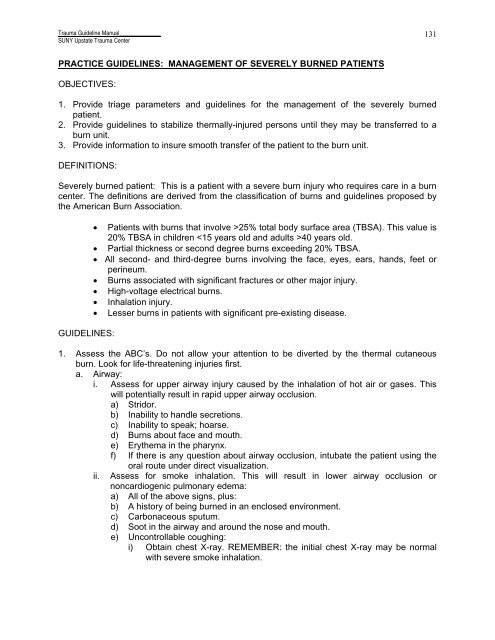Trauma Guideline Manual - SUNY Upstate Medical University
Trauma Guideline Manual - SUNY Upstate Medical University
Trauma Guideline Manual - SUNY Upstate Medical University
Create successful ePaper yourself
Turn your PDF publications into a flip-book with our unique Google optimized e-Paper software.
<strong>Trauma</strong> <strong>Guideline</strong> <strong>Manual</strong>______________<strong>SUNY</strong> <strong>Upstate</strong> <strong>Trauma</strong> Center131PRACTICE GUIDELINES: MANAGEMENT OF SEVERELY BURNED PATIENTSOBJECTIVES:1. Provide triage parameters and guidelines for the management of the severely burnedpatient.2. Provide guidelines to stabilize thermally-injured persons until they may be transferred to aburn unit.3. Provide information to insure smooth transfer of the patient to the burn unit.DEFINITIONS:Severely burned patient: This is a patient with a severe burn injury who requires care in a burncenter. The definitions are derived from the classification of burns and guidelines proposed bythe American Burn Association.GUIDELINES:• Patients with burns that involve >25% total body surface area (TBSA). This value is20% TBSA in children 40 years old.• Partial thickness or second degree burns exceeding 20% TBSA.• All second- and third-degree burns involving the face, eyes, ears, hands, feet orperineum.• Burns associated with significant fractures or other major injury.• High-voltage electrical burns.• Inhalation injury.• Lesser burns in patients with significant pre-existing disease.1. Assess the ABC’s. Do not allow your attention to be diverted by the thermal cutaneousburn. Look for life-threatening injuries first.a. Airway:i. Assess for upper airway injury caused by the inhalation of hot air or gases. Thiswill potentially result in rapid upper airway occlusion.a) Stridor.b) Inability to handle secretions.c) Inability to speak; hoarse.d) Burns about face and mouth.e) Erythema in the pharynx.f) If there is any question about airway occlusion, intubate the patient using theoral route under direct visualization.ii. Assess for smoke inhalation. This will result in lower airway occlusion ornoncardiogenic pulmonary edema:a) All of the above signs, plus:b) A history of being burned in an enclosed environment.c) Carbonaceous sputum.d) Soot in the airway and around the nose and mouth.e) Uncontrollable coughing:i) Obtain chest X-ray. REMEMBER: the initial chest X-ray may be normalwith severe smoke inhalation.
















